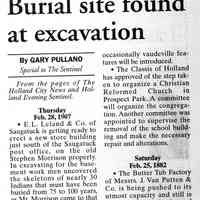Traces of the Original Settlers of Saugatuck
Archive
For the early days of Saugatuck burial sites of Native American residents have been inadvertently exhumed from time to time. William G. Butler, in correspondence with his father, noted the location of one of their sacred burial sites, the spot where the Saugatuck village hall now stands, and the lands south and west of that point to the Kalamazoo River.
In 1869 while a fence was being constructed around Stephen Morrison's home, at Culver and Butler streets, bones were found. Years later when the village hall was having a basement excavated under it, bones were found which were displayed in the hall for many years.
Burial sites found in any other location around town were considered to be quite uncommon. The local paper was quick to make mention of the discovery of one of these rare sites was described in the "Commercial Record" of December 1, 1893:
"While excavating at the corner of Mason and Water Streets last Thursday workmen unearthed the skeleton of a man only a foot or two below the surface, and the peculiar position it occupied gave rise to much curiosity and comment. The body had evidently been buried in a doubled up manner, as the head, feet and hands were close together, as though it had been carried by two persons and dropped in a hole. The bones were but slightly decayed, and the body must have been buried upwards of twenty years. Whether the bones were that of a white or an Indian cannot be told, but the opinions of those that have seen the skull is that is that it is of the former. The point of land that elbows into Kalamazoo Lake is full of bones of dead Indians, and they are frequently disinterred, but never so far from the bend as where the recent find was made."
What made this find most unusual, other than location, was the manner of burial which led speculators to conclude it was not the grave of a "noble" red man, but of some other unfortunate. Some insight into this rare manner of burial is found in an account given by James McCormick, adopted son of early Allegan County settler, Hull Sherwood. In an 1873 "Allegan Journal" he tells the story of an Indian burial near Saugatuck. The time of the tale is the early 1830's.
"There was a chief among them [the Indians which frequented the Pine Creek settlement near Otsego] named "Ring Nose," so called on account of his wearing a ring in his nose. He was a tall Indian, a great hunter, and somewhat eminent as a talker. I once heard him make an address at the funeral of an Indian near Saugatuck, where the Indians had a burial place. The address was to the dead Indians, who was placed in a sitting posture in a shallow grave, with his weapons and his others things. The brave was covered with brush poles and dirt. .."
The manner of burial above described: shallow grave, seated position, very aptly describes the type of grave found on that December day in Saugatuck. The brush and poles placed around the body would have decomposed rapidly allowing the bones to settled under the weight of the soil, giving the appearance of having been folded up, i.e., the hands and skull by the feet.
As to the uniqueness of the gravesite, three or four years ago, during street work near the Village Square, a skull was found that was assumed to be of Native American origin.
No doubt many more of these sites will be found in the years to come.
- Bill Kemperman
![Commercial Record [Lake Shore Commerical], December 1, 1893, front page, 2nd collumn](https://d8e7jbdw4fu0e.cloudfront.net/4124/baef93b0-7e84-11ee-92a8-612d9be78ddf-vGHJfz8.lg@2x.jpg)
2023.50.25
SDHS NL InsertsCemeteries and graves0001 Anishinabek/Ojibwe/Odawa/Bodéwadmi
Winthers, Sally
Digital data in CatalogIt
This information was OCR text scanned from SDHS newsletter supplements. A binder of original paper copies is catalog item 2023.50.01
11/08/2023
11/18/2023

![Commercial Record [Lake Shore Commerical], December 1, 1893, front page, 2nd collumn](https://d3f1jyudfg58oi.cloudfront.net/4124/image/baef93b0-7e84-11ee-92a8-612d9be78ddf-uV4LWM2.tn.jpg)
